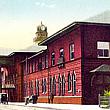
Maybury Photo Essay
by Shirley M. De Boer
published: September 16th, 2015
Generations of New England families migrated across New York after the Revolutionary War; the wave of newcomers reached Michigan in the mid 1830’s and lasted into the 1880’s. Frank Maybury, his wife Maria and children Mabel and De Forest journeyed from Cortland County, New York and arrived in 1872 Grand Rapids to find a population of sixteen to seventeen thousand, which was about the same number of people in Sacramento, California. The Mayburys lived in our city for ninety years and left a cemetery monument of striking distinction at Valley City Cemetery now known as Oak Hill. For the past century and more visitors have viewed the beautiful tree memorial and pondered the meaning of its severed tree limbs, the exquisite calla lily and an uplifted cross, without the benefit of information. Following is the Frank and Maria family story.
Maria Kelsey was born in Little Valley, Cattaraugus County, New York on 1 September 1843. Her mother, Laura Olin, was known by some as “the belle of the Mohawk,” when at age eighteen in 1825 she married Truman Kelsey, Maria’s father, in Florida, Montgomery County, New York. Before 1827, the couple migrated to the far uncultivated western part of the state where it was not unusual for young adult children to return east and live with relatives to reach their particular goals. Maria had six sisters and six brothers, the youngest born in 1851; their mother died in 1856. Maria had reached the age of twelve. One sister named Cleopatra and known as Clio, was a young adult in those pre-Civil War days and studied to become a teacher at the Cortlandville Academy in Homer while living in Cortland County, New York with their paternal aunt, Arsinoe (Kelsey) Bowen, wife of Rev. Henry Bowen, a Baptist clergyman. Later, Clio married Dr. James Washburn Hughes of that place.
In 1860 a train station and small settlement in Pennsylvania’s Erie County was insignificant, but by 1870 the hamlet had become a thriving city named Corry with a population of nearly 7,000. Oil had been discovered in the northwest area of the state and the first successful oil well was drilled in 1859 near Titusville, 24 miles south of the train station. During the 1860’s decade, a refinery and rail transportation developed in Corry that reached all markets, east, west, north and south. As the town grew, workers of all kinds were needed to meet the needs of the rising population. Early in the Civil War years, Maria, about eighteen, left home to live with her sister Clio in Cortland, attended the Cortlandville Academy, and became a teacher. She may also have become acquainted with Frank Maybury, who lived in a neighboring township. In the fall of 1865, it is probable that Maria found a teaching position in Corry, about seventy miles from her place of birth. [For a full view of Corry in 1870, see author’s notes]
This courthouse, built in 1836 Cortland County, was familiar to four generations of Maybury families. Frank Irving Maybury was born in 1845 Solon Township to Josiah and Dorcas (Blake) Maybury. Coincidently, the courthouse, after serving the county for eighty-eight years, burned in 1924, the same year Frank died seven miles from his boyhood home. But that’s getting ahead of the story. Frank worked at home until age nineteen when he enlisted in the Civil War, in Company F, 185th New York Volunteer Infantry and was discharged in May 1865.
After the war, it is probable that Frank was employed on a train or he may have found work in Corry, because Frank and Maria were married in Corry on October 29, 1866. The newlyweds returned to Marathon in Cortland County to reside. Their first known child, Frank K., born in 1867, died there at age fifteen months. A daughter, Mabel B. was born in 1870 and a son, DeForest in 1872. At about that time, the Frank Maybury family moved to Grand Rapids, Michigan. [For a photo of Frank, see author’s notes]
Baby girl Birdie was born in this city January 1, 1876. Traveling to Cortland that year for Christmas, the Maybury family no doubt looked forward to happy times but while there, Birdie became sick and her young body could not stave off pneumonia; she died the day after Christmas at Blodgett Mills, five days before her first birthday. A daughter Margaret L, nicknamed Maggie, was born here in 1878, but there was need for a coffin again in 1879 when seven-year-old De Forest died from scarlet fever. Later, Frank and Maria were expecting another child, but the mother lost her life, as did the child, perhaps a son, on February 9, 1884. Though no death record for Maria exists, she is enumerated in the 1884 Grand Rapids directory death list. Oak Hill Cemetery records confirm that Maria’s death was related to childbirth. The lives of the three known little ones, Frank, Birdie and DeForest are represented by the three short stumps at the bottom of the monument.
Frank was a ticket agent for the Grand Rapids & Indiana Railroad beginning in 1872 and soon became a traveling passenger agent, a positon that he held for many years. [Click on image for more train detail] Mabel was fourteen in 1884 when the girls lost their mother and she remained with her father at 657 Madison Avenue, but Maggie, only six, lived with her aunt, Mrs. Clio Hughes in Cortland County, New York. In late 1885, Frank married Anna Rose (Bradford) Long, daughter of Major Stephen N. and Adelia (Weidman) Bradford, a former commissioned Civil War officer in Company S, Pennsylvania 77th Infantry Regiment. Bradford family members lived in Grand Rapids and Ravenna. Frank resigned his post with the railroad company in 1894 and the Grand Rapids Evening Press reported, “Mr. Maybury has been in the employ of the company for the past 22 years, 18 of which he acted as traveling passenger agent, and has made miles and miles of friends for himself and the company.”
After leaving the railroad position, Frank became manager, and later proprietor, of a School and Office Supply Company, located at 105-107 Ottawa in the Ledyard Building; daughter Mabel worked as clerk and bookkeeper. Frank managed the supply business until 1910, and also served as a member of the City’s Board of Education. Maggie had returned home, graduated from the Grand Rapids high school class of 1898, and begun her career teaching deaf students. The girls enjoyed local social events and parties. Both Margaret and “Maybelle,” [Mabel]; joined the Daughters of the American Revolution, Sophie de Marsac Campau Chapter in Grand Rapids; and for a time Mabel served as Corresponding Secretary. The girls’ paternal ancestor was Sgt. Ebenezer Blake 1761-1843 and their maternal forefather was Pvt. Giles Olin, 1745-1835. The Grand Rapids Press printed on 11 May 1908, “Mr. & Mrs. Frank I. Maybury of 657 Madison ave. [sic] announce the engagement of their daughter, Margaret Laura to B. Harvey Everhart of Rochester, N.Y., the wedding to take place in June.”
In September 1899, the oral method of instructing the deaf was established in Grand Rapids and Maggie taught there from that time until her marriage. [See related article] Simultaneously she also graduated from the Milwaukee School for the Deaf and instructed in Traverse City. History has forgotten Maggie but at the time, her tenure and salary were higher than others. Frank’s second wife Anna, Maggie’s mother for twenty-three years, died six weeks prior to Maggie’s wedding but as planned in June 1908, Frank and Maria’s daughter Margaret married, in Grand Rapids, Bert [Albert] H. Everhart son of Frank and Nellie (Phelps) Everhart. The newlyweds settled in Wayne County, New York. Seventeen months later on 14 November 1909, Maggie died in South Butler, NY from acute Bright’s disease. The following Friday, the Cortland [NY] Standard reported, “Some of our readers will remember Mrs. Everhart as ‘Puss Maybury,’ who when a child on the death of her mother spent several years with her aunt [Clio] Mrs. J. [James] W. Hughes.” Margaret was brought to Oak Hill for burial.
Looking south from lower Monroe Avenue, this interesting photo reveals horse drawn vehicles and electric street cars, both were part of Mabel’s early life. Her probable uncle owned “Edward Gill’s Hacks” at 103 Ottawa when she was young. She viewed transportation changes from horses to automobiles and just short of seeing men land on the moon. After Anna’s death Frank had married Florence (Aldrich) Summerlin, lived in California and finally settled in Homer, Cortland County, New York where he died in 1924. Mabel traveled to New York, arranged his funeral and returned home with his body for burial; Frank’s third wife returned to Indiana. Mabel never married. She resided here alone for fifty years though on holidays she was invited to the home of Gill relatives. She worked as a clerk, bookkeeper, stenographer and sales lady and considered herself an artist. A member of Fountain Street Baptist Church, she later found interest in Christian Science. She died in 1961 having reached age 91 and was interred with her family.
The love of Frank’s life and his child were gone, and though he cherished his two daughters, there would not be a son with whom to play and invest himself as a father, no future grandsons to carry the Maybury name, and no males to add to military lineage. In the weeks or perhaps months that followed, Frank may have ordered the Treestone memorial from any one of the numerous small mills operating in the 1880’s in the Indiana Limestone Belt (roughly 20 miles long and 6 miles wide) from Stinesville to Bedford, Indiana. The piece was probably fabricated and carved by one of the many immigrant artisans that were brought in from Italy and other European countries to man the area mills. Frank found the faith and fortitude to marry again and Mabel, a true Grand Rapids girl, lived here almost a century, but there was not a descendant of Frank and Maria Maybury to tell their story. The imposing symbol stands to remind its viewers of faith, hope and love.

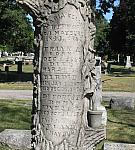
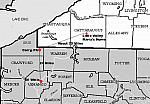
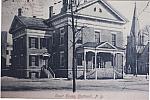
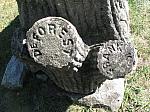

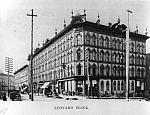

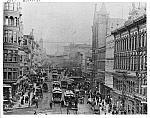
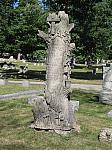
 facebook
facebook